Learn the 3 main types of SEO—on-page, off-page, and technical SEO. If you’re just beginning your SEO journey, congratulations! You’ve taken the first step toward boosting your online visibility. These three types work together to help search engines understand, rank, and recommend your content. In this beginner-friendly guide, we’ll break down each type of SEO with simple explanations and practical tips.
By the end, you’ll know which SEO type to focus on first and how to take action. Don’t forget to grab your free SEO audit checklist at the end to start improving your site today!

Table of Contents
Before diving in, first understand what SEO is SEO (Search Engine Optimization) is the practice of improving your website’s visibility in search engines to attract more organic (non-paid) traffic. For a deeper understanding of What is SEO, check out our previous blog.
What Are the 3 Types of SEO?
Search engine optimization is divided into three essential areas:
On-Page SEO 📝 – Optimizing elements on your website (content, HTML tags, keywords).
Off-Page SEO 🔗 – Building trust and authority off your website (backlinks, social sharing).
Technical SEO 🛠️ – Improving your website’s infrastructure (speed, mobile-friendliness, crawlability).
Think of these as the three pillars that support your website’s success in search engine results.
📄 On-Page SEO: The Content Side
On-page SEO refers to the strategies you apply directly on your website to help search engines understand your content and deliver it to the right audience. This type of SEO is fully under your control.
Key Elements of On-Page SEO:
Title Tags: Your page titles should be clear, keyword-rich, and under 60 characters.
Meta Descriptions: These short descriptions (under 160 characters) appear in search results and influence click-through rates.
Header Tags (H1, H2, H3…): These organize your content, making it easier for readers and search engines to navigate.
Keyword Placement: Use your primary keyword in the title, URL, first 100 words, and at least one subheading.
Internal Linking: Link to other related blog posts or pages within your site to build topic relevance.
Image Optimization: Use descriptive file names, alt text, and compressed images to improve page speed and accessibility.
Example in Action:
Suppose you’re writing a blog titled “Digital Marketing Tips for Beginners.” Make sure that phrase appears in the title tag, URL (e.g., yoursite.com/digital-marketing-tips), opening paragraph, and at least one subheading. Add relevant internal links to related content, and use images with alt tags like “digital marketing tips chart.”
🔗 Off-Page SEO: Building Your Site’s Reputation
Off-page SEO involves activities that happen outside of your website but influence how search engines and users perceive your site’s trustworthiness and authority.
Key Techniques:
Backlink Building: Earn backlinks (incoming links from other websites) by creating valuable, shareable content.
Guest Blogging: Write articles for other reputable sites and include a link back to your own.
Social Media Sharing: Promote your content across social platforms to increase visibility and traffic.
Brand Mentions: Get other websites to mention your brand name even without a direct link.
Quality Matters:
One high-authority backlink from a trusted website (like Forbes or HubSpot) is more valuable than dozens of low-quality links. Avoid shady link-building practices, like purchasing backlinks, as they can harm your site.
⚙️ Technical SEO: Optimizing the Backend
Technical SEO ensures that your site is properly configured for search engines to crawl and index your content. Even if you have excellent content, poor technical SEO can prevent it from showing up in search results.
Key Aspects of Technical SEO:
Mobile-Friendliness: Your site must be responsive and work well on all devices.
Page Speed: Fast-loading pages improve user experience and reduce bounce rates. Use tools like Google PageSpeed Insights.
XML Sitemap: Submit your sitemap to Google so that it can discover your content faster.
Robots.txt: Control which parts of your site search engines can or cannot crawl.
HTTPS: Secure your website with SSL to build trust with users and improve rankings.
Tools to Use:
Google Search Console: Monitor site performance, index status, and fix technical issues. https://search.google.com/search-console/about
Screaming Frog: Analyze technical aspects like broken links, redirects, and meta tags. https://www.screamingfrog.co.uk/seo-spider/
Google Page Speed Insights https://pagespeed.web.dev/
Where Should Beginners Start?
If you’re new to SEO, start with on-page SEO. It’s the most straightforward and yields quick wins. Focus on writing helpful, keyword-targeted content, optimizing your meta tags, and improving internal linking.
Once your content is solid, move on to off-page SEO by building relationships, earning backlinks, and increasing your brand visibility online.
Lastly, review technical SEO fundamentals, especially if you’re using WordPress or a drag-and-drop website builder. Ensure your site is mobile-friendly, loads quickly, and is secure.
Common SEO Mistakes to Avoid
On-Page SEO Mistakes:
Stuffing keywords unnaturally into the content.
Using duplicate title tags or missing meta descriptions.
Off-Page SEO Mistakes:
Buying backlinks or participating in link schemes.
Ignoring your brand’s social media presence.
Technical SEO Mistakes:
Having a slow website with uncompressed images.
Broken internal links or a missing sitemap.
Avoid these common pitfalls to protect your rankings and provide a better user experience.
📥 Conclusion
Understanding the three types of SEO—on-page, off-page, and technical—is the foundation of a strong digital strategy. Each one plays a unique role in helping your website appear in search results, drive traffic, and build trust with your audience.
✅ Ready to level up your SEO?
Grab our FREE SEO Audit Checklist — an easy-to-follow, interactive guide that helps you spot and fix SEO issues on your site fast.
👉 [Download Now] and start optimizing like a pro!
🎯 Don’t just read — take action! Get your hands on our FREE SEO Audit Checklist and see where your site stands.
💬 Comment below: Which type of SEO are you focusing on right now?
And for daily SEO tips and tricks, don’t forget to follow @theseobrief!


1 thought on “Types of SEO: Boost Your Google Rankings with These 3 Essential Strategies”